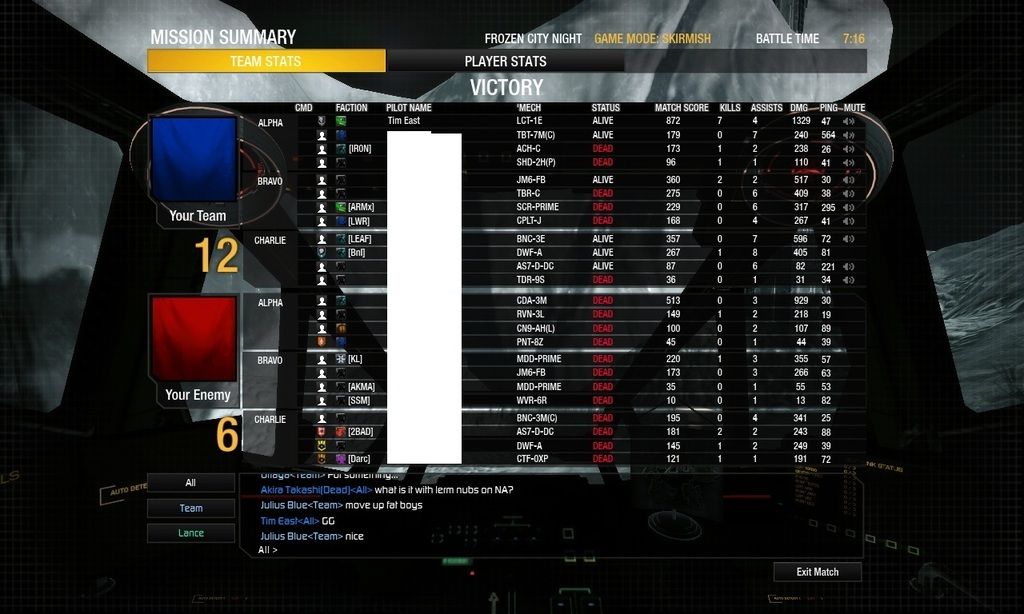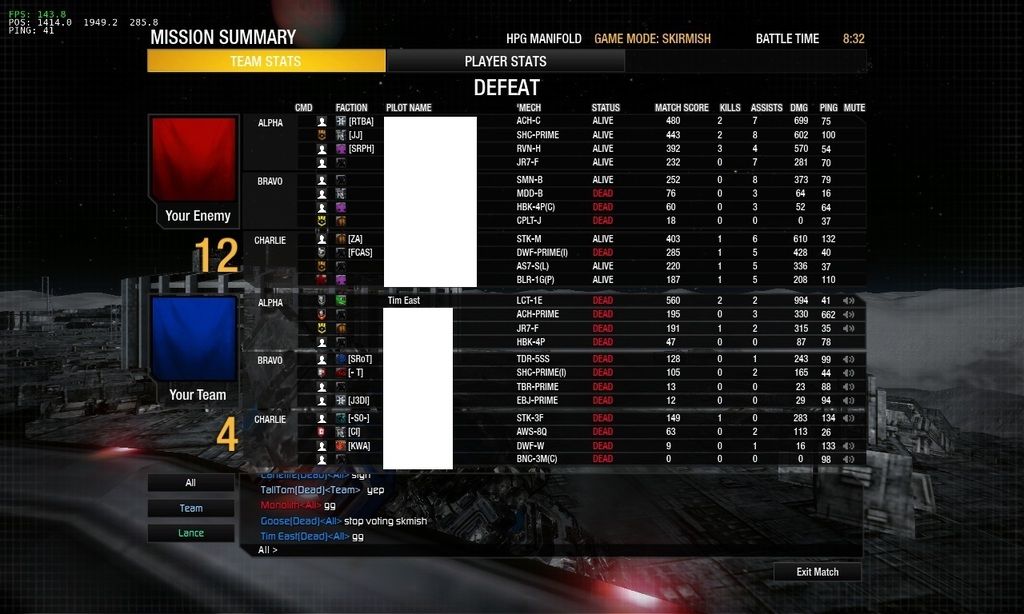 Ovion, on 16 November 2015 - 02:54 AM, said:
Ovion, on 16 November 2015 - 02:54 AM, said:
My main question is though, will I remain able to dodge AC20 fire with thise loss of almost 4kph?
Pretty sure you still can for heavies and assaults. Not sure about mediums like the YLW or any AC20 hunchie, though. Dodging is completely and entirely up to both players' skills (their poor aim vs your unpredictability) in the frontal arc, so I won't even cover that. But what I can cover is calculating what distance you can hold to be completely immune to fire, because you're too close to them to be tracked (heh, trench run anyone?)
What it comes down to is to be able to exceed the turning rate (degrees/sec) at a certain combat distance.
Assume you are fighting a victim at a given distance, R. Your lolcust is travelling at V kph ( V / 3.6 in m/s). Your victim can turn his legs at YL degrees/sec, and his torso at YT degrees/sec.
There are two possible scenarios. One at which his torso yaw has already maxed out (you're flanking so hard that he has to turn his whole mech), and another where he has to turn to face you. In order for him to face you, he must be able to turn at such a rate that the distance his vision covers at distance R is
less than the distance you cover in your locust in the same period of time.
The formula for finding the distance of being completely immune to return fire in 1v1 is this:
V = velocity (of your locust, km/h)
R = radius, in metres (distance to target -- I mean, victim)
YT = yaw rate of torso, in degrees/sec
YL = turning rate of legs, in degrees/sec
((V / 3.6) / (2 * Pi * R)) * (360 degrees) > YT + YL
For the case of torso being maxed out, set YT to 0.0 deg/s.
So let's cover the two cases. Assume that the lolcust is travelling at maximum velocity, and that it is capable of maintaining that speed on flat ground, and is able to travel a full circle without obstructions. Assume Pi is 3.14.
1) Torso yaw not maxed: case study, Dire Whale. DWF can torso twist at 60deg/s, and it can turn at 34deg/s.
V = 170 / 3.6 = ~48m/s
YL + YT = 34deg/s + 60deg/s
Degrees locust can travel in 1 second, at a distance of R: (48 / (6.28 * R)) * 360.
For a locust to be completely safe from a DWF:
= (48 / (6.28 * R)) * 360 > 34 + 60
= (48 / (6.28 * R)) * 360 > 94
Solving for R:
= (48 * 360) > 94 * (6.28 * R)
= (48 * 360) > (94 * 6.28) * R
= (48 * 360) / (94 * 6.28) > R
= ~29.272 > R
Therefore, a lolcust needs to be within 29m of a DWF with both torso twist and leg movement to be unable to be targeted.
2) Torso yaw maxed: Case study, Dire Whale.
Following the above:
= (48 / (6.28 * R)) * 360 > 34 + 0
= (48 / (6.28 * R)) * 360 > 34
Solving for R:
= (48 * 360) > 34 * (6.28 * R)
= (48 * 360) > (34 * 6.28) * R
= (48 * 360) / (34 * 6.28) > R
= ~80.929 > R
Therefore, a locust that has completely flanked a direwhale can safely engage at 80m without fear of getting shot at, assuming that he maintains 170km/h and the direwhale continues rotating at maximum rate.
In other words:
Safe radius R = ((V / 3.6) * 360) / ((YT + YL) * 2 * Pi). If you are within R, congratulations, you can now murder the mech in front of you at will.
This radius grows very, very small as the yaw total goes higher. I don't expect the lolcust to be completely immune to return fire against any mediums or lights, because their yaw is quite high (for reference, a SCR is 68deg/s leg, 120 deg/s torso). But even with a reduction of around 5km/h, this is a reduction of only about 1.5m/s. Against heavies and assaults, this just means you need to close the gap by another 2-3m or so if their torso yaw is locked.
Edited by ArcturusWolf, 16 November 2015 - 04:02 PM.



 3xnihilo, on 07 November 2015 - 10:05 AM, said:
3xnihilo, on 07 November 2015 - 10:05 AM, said:

 Tim East, on 07 November 2015 - 08:43 PM, said:
Tim East, on 07 November 2015 - 08:43 PM, said:

 mad kat, on 11 November 2015 - 08:57 AM, said:
mad kat, on 11 November 2015 - 08:57 AM, said: Donatello Jones, on 14 November 2015 - 06:32 AM, said:
Donatello Jones, on 14 November 2015 - 06:32 AM, said: Ovion, on 15 November 2015 - 07:51 AM, said:
Ovion, on 15 November 2015 - 07:51 AM, said: Ovion, on 15 November 2015 - 07:51 AM, said:
Ovion, on 15 November 2015 - 07:51 AM, said: 3xnihilo, on 15 November 2015 - 10:24 AM, said:
3xnihilo, on 15 November 2015 - 10:24 AM, said: Tim East, on 15 November 2015 - 08:20 PM, said:
Tim East, on 15 November 2015 - 08:20 PM, said: Ovion, on 16 November 2015 - 02:54 AM, said:
Ovion, on 16 November 2015 - 02:54 AM, said: TimePeriod, on 15 November 2015 - 06:26 AM, said:
TimePeriod, on 15 November 2015 - 06:26 AM, said: